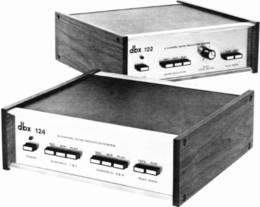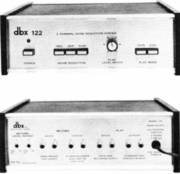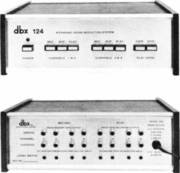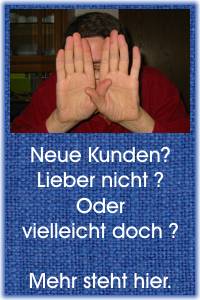Dieser kleine dbx Prospekt scheint aus 1974 zu sein.
Das könnte man aus der ID auf der letzen Seite entnehmen. Das müsste aber nochmal überprüft werden.
dbx120 series (1974)
noise reduction system and dbx disc decoder - professional quality noise reduction for the audiophile !
.
- Anmerkung : Zu Zeiten der analogen schwarzen Scheiben als die einzigen erschwinglichen Programmquellen war das sicher ein "audiophiles" Erlebnis. Doch das kann in 2015 mit den erreichten Qualitäten moderner Musik-Quellen lange nicht mehr mithalten.
.
Model 122 features
Two channel record or playback noise reduction system (with channels switched in tandem) and dbx disc decoder.
Model 124 features
Four channel record or playback noise reduction system (with channels switched in pairs) and dbx disc decoder. Can also be used as a two channel simultaneous record and playback noise reduction system.
application
The dbx 120 series of audiophile noise reduction systems is designed for use with any reel-to-reel, cassette or cartridge tape recorder of reasonably good quality. While the dbx noise reduction system enhances the performance of any sound system with which it is used, the better the quality of the associated components, the better will be the audible result. The units in this family interface with any device operating at line level and having single ended lines terminated by RCA type phono plugs.
dbx 120 audiophile noise reduction units may be used for original recording of live programs, for dubbing or duplication of tapes from one machine to another or one medium to another, or for taping broadcasts off the air, for transferring material from discs to cassettes, etc.
For tape dubbing and duplication and recording off the air, the dbx system is normally connected to the tape monitor inputs and outputs of the audio system preamp or receiver. The dbx unit may also be connected directly between one recorder and another, or between tuner and recorder without going through the preamp or receiver. For live recording, a separate microphone preamp or mixer may be required to drive the line level inputs of the dbx noise reduction system.
.
description
dbx Inc. has perfected a tape noise reduction system which allows the input signal to be reproduced with full dynamic range while effecting a 30dB reduction of noise contributed by the tape recording process. (We do not, however, attempt to remove noise present in the original input signal.)
Like dbx professional noise reduction systems, the 120 series (although incompatible with the professional series) uses 2:1 linear decibel compression and expansion over the entire dynamic range. High frequency pre-emphasis and de-emphasis are employed to minimize mid-frequency distortion and tape modulation noise and minimize high frequency tape saturation. The 120 series achieves 10 dB improvement in headroom and in excess of 30 dB of noise reduction. This compander system uses compression in recording and expansion during playback.
For companders to work effectively, the expander must be able to exactly restore on playback the dynamics which were originally compressed during recording. All recorders introduce phase shifts which make it difficult for conventional compander systems to properly re-create the input signal. The dbx system precisely reproduces the original sound regardless of recorder phase shifts over a 100 dB range even on music containing percussive peak transients. The unique simplicity of the system eliminates the need for level match tones.
An additional feature of the 120 series is its ability to reproduce dbx encoded discs. The limitations in the disc and tape recording process make it impossible to manufacture a record capable of reproducing the full dynamic range of music played live, dbx encoded discs (commercially available) provide the listener with the full excitement of the original performance and totally eliminate disc surface noise. Only when tape hiss and disc surface noise are completely eliminated via the dbx noise reduction system does one realize how pervasive background noise has been in recorded music.
how it works
The dbx noise reduction system uses dynamic range compression to encode the signal before recording and a matched expander to restore the original dynamics on playback. The compression and expansion factor is 2:1 and is linear in decibels over a 110dB range. A 20dB change in the program is recorded as a 10dB change on the tape. Thus, a recording medium capable of only 55dB signal to noise ratio can record and reproduce the full dynamic range of live music which often exceeds 100dB. Level matching on playback is unnecessary for proper decoding as this factor is the same at all levels. The adjustments provided for playback level are only for convenience and prevention of overload of succeeding audio stages.
Frequency weighting networks are used on both the signal and level sensing circuits in the encoder and decoder. This optimizes performance in terms of mid-frequency distortion, tape modulation noise, the audibility of phonograph mistracking, and high frequency overloading of recording media.
The dbx compression-expansion noise reduction system consists of two voltage controlled amplifiers and two level sensors, there being one of each in the encoder and decoder. If the two level sensors track, the gain change instructions given to the encode and decode voltage controlled amplifiers will be equal and opposite.
All recording systems have some frequency dependent phase shift which changes waveforms considerably even though the sound is not audibly degraded, dbx gets around this problem by using wide range RMS (root-mean-square) level sensing circuits which calculate the sum of the signal energies, regardless of their phase relationships. This results in excellent code-decode gain tracking even with extremely fast transient rise times and a wide range of input levels.
.
Made in U.S.A. Revised 09-1974-20M
.





